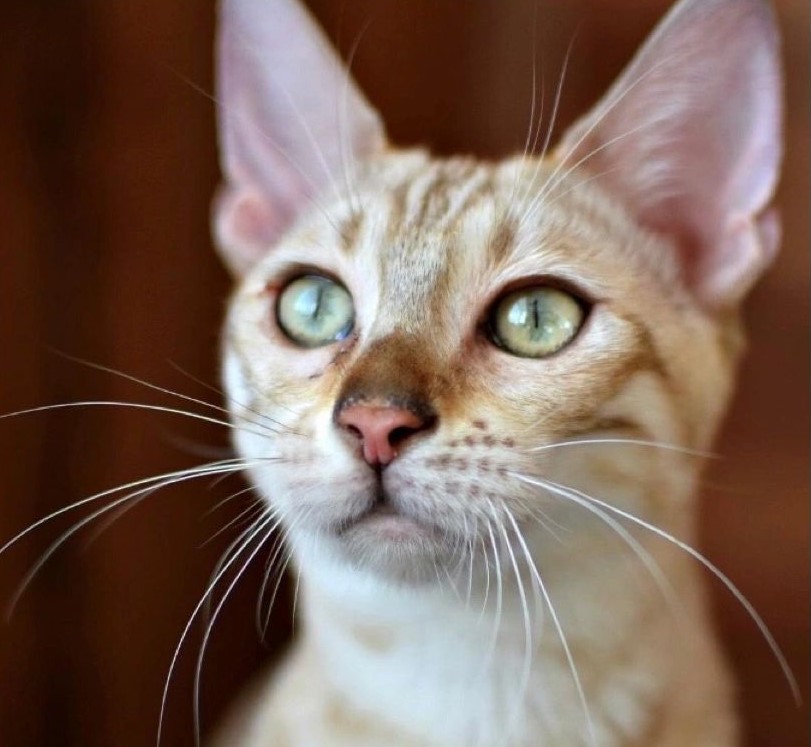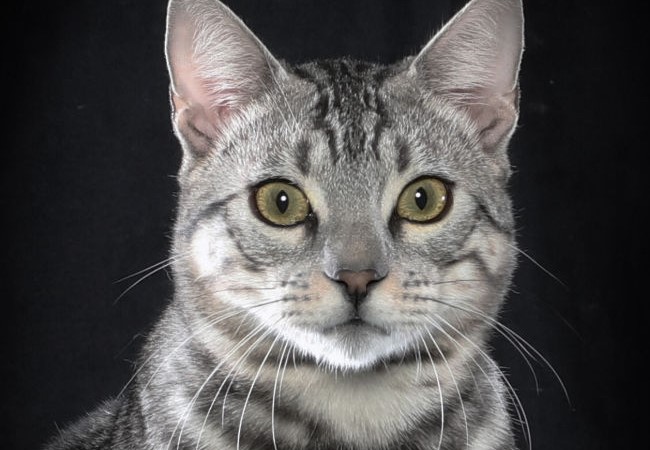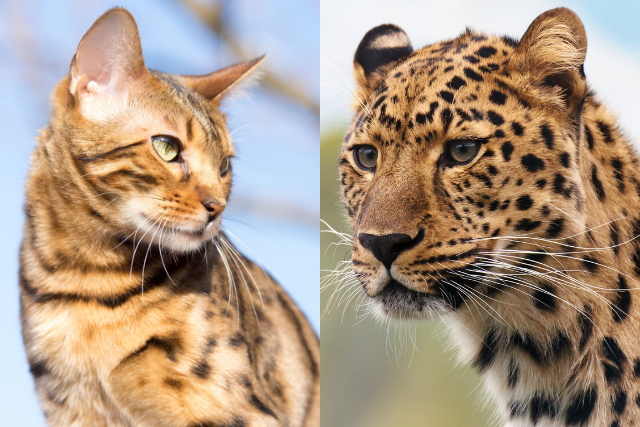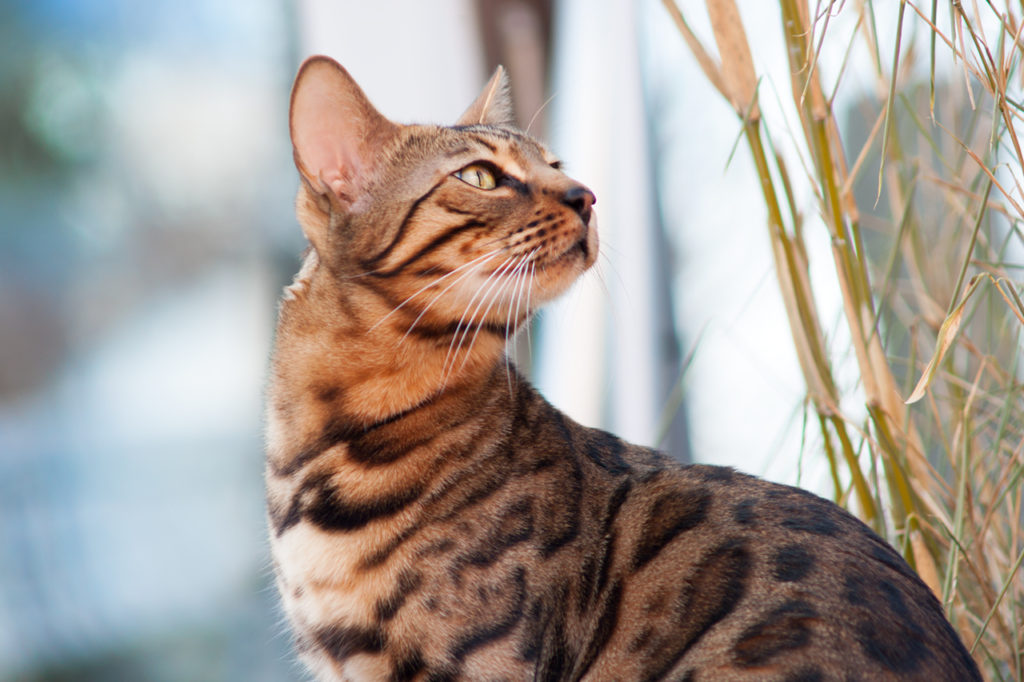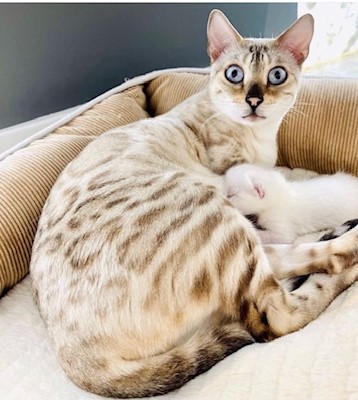
This guide covers all, or at least the main, aspects of snow Bengal cats.
It won’t tell you what they smell like though, for example.*
Snows have become a desirable addition to the Bengal breed but it can be hard to determine exactly what a snow Bengal is and what sets one apart from its ‘other coloured’ kin.
To make things more confusing, snows can be split into sub-categories, plus there are questions relating to size, cost and life expectancy.
This guide will address those topics, plus others you may not have considered and will equip you with all kinds of snow Bengal based knowledge.
* A bit biscuity.
Topic Overview
You may have seen photos of white coated, Snow Leopard looking domestic cats, often with blue eyes.
These are likely to have been snow Bengals.
However, not all snow Bengals are the same, and breeding has created diversity within snows themselves.
Their base fur, markings and even eye colour can differ which we shall see.
But first, let’s discover how snow Bengal cats were brought into existence…
How Snow Bengal Cats Were Created
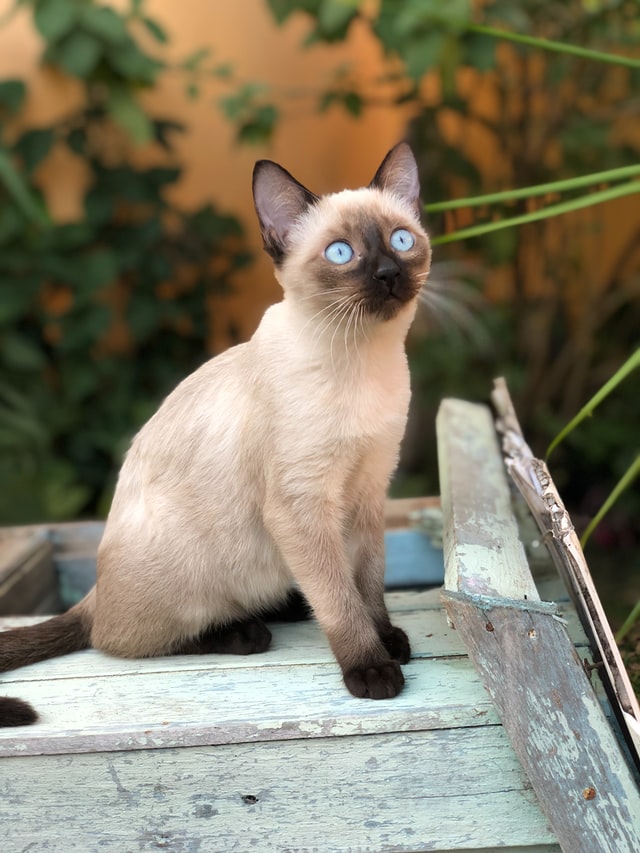
As you may already know, Bengal cats today are descendants of an original cross made between a domestic cat and an Asian Leopard cat.
Snow Bengals first came into being after a Siamese cat was introduced into a Bengal breeding program.
It’s from the Siamese that the original snow Bengal cats acquired their white or light brown base fur colour.
In order to understand further how snow Bengals today were bred into existence, we need to delve briefly into genetics…
Snow Bengal Cat Genetics
The reason why Siamese cats appear white is because they possess an allele (which is a variant of a gene that codes for a specific trait) that inhibits pigment formation.
The inhibition of pigment formation is called albinism.
Interestingly, in Siamese cats, this is temperature sensitive, in that it works more effectively in warmer parts of the body.
There is LESS inhibition in the cooler extremities, which on the cat appear black- for example, the ears and the area around the nose.
This is called ‘pointing’ or ‘point colouration.’
We’ll see how this is relevant later…
But back to snow Bengals.
This Siamese colour inhibitor gene variant is recessive– which means in order for the phenotype (physical characteristic) to be displayed, a cat must carry both copies (one from its mother and one from its father).
The introduction of the Siamese gene (CS) gave rise to what’s now called the ‘Seal Lynx Point’ or for short ‘Seal Lynx’.
These cats are genetically described (genotypically) CS/CS.
See the table below:
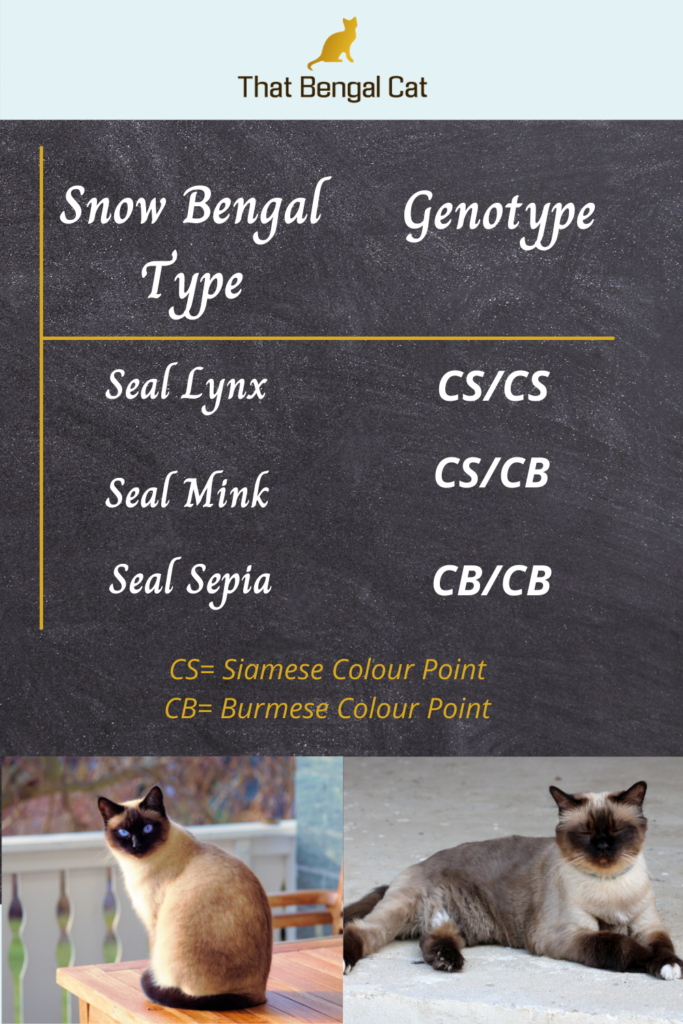
As I’m sure you will have noted, the Bengal gene pool has been enlarged further by adding some genetic information from Burmese cats.
This meant snow Bengals split into the 3 distinct types listed, which we will look at after introducing some of their common traits…
Common Physical Traits… and Glitter
Bengal cats snow, brown or silver, will either have a marbled or spotted/rosette pattern that is typically darker and contrasts with their lighter base fur (for more detail on Bengal patterns, see Bengal Rosetted Patterns: The Beginner’s Guide).
Bengal fur can sparkle in a rather unique manner.
This Bengal ‘glitter’ effect is caused by light reflecting off individual hairs that are both hollow and translucent.
Not all Bengals will possess a coat that shines in this manner, and this is also true of snow Bengals.
But all snow Bengal cats do have a dark seal brown tail tip.
So, there are three distinct snow Bengal groups for us to look at, plus silver snows also get a brief mention, as do charcoals, but we’ll start with the snow seal lynx…
Snow Seal Lynx Bengal
Generally considered to have the whitest or palest fur of all the snow Bengals, the seal lynx Bengal is also referred to as the ‘Seal Lynx Point’.
In the ‘Genetics’ part of this guide, I mentioned the impact of the Siamese inhibitor gene variant on the colouration of the Siamese cat.
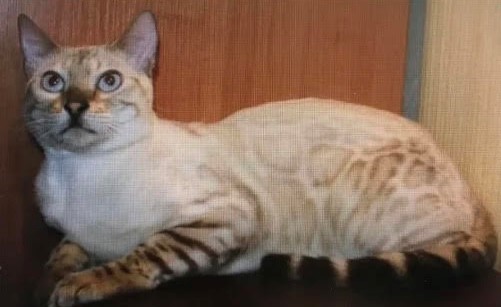
As mentioned, the darker face, tail, feet and ears are features called pointing.
So as you may have guessed, a seal lynx point will also display these characteristics, albeit in a less pronounced fashion.
The ‘Lynx Point’ part of the name refers to the fact that the ‘pointed’ areas on the cat’s body have tabby/striped markings.
Interestingly, strong pointing patterns are not sought after by breeders who intend to show their cats at is does not adhere to the Bengal cat breed standard.
What does ‘Seal’ mean? Yes, it actually does originate from the marine mammal of the same name. Seal is a shade of brown- seal brown in effect. Therefore ‘seal point’ means the cat has a solid shade of brown in those pointed areas.
Lynx Bengal kittens are born completely white, and only after a week or so do they start developing their contrasting darker colours.
Only after some months will a kitten’s true and final colour appear, and this can be a light brown/tan which can almost look orange around the nose.
Unique to the seal lynx snow Bengal is eye colour as it the sole owner of blue eyes.
Again, it has it Siamese genetic history to thank (or not if it doesn’t like them…)
Expect to find snow lynxes with a pink nose.

Instead of the Siamese, our next snow Bengal variant can attribute some its look from a different cat breed…
Snow Seal Sepia Bengal
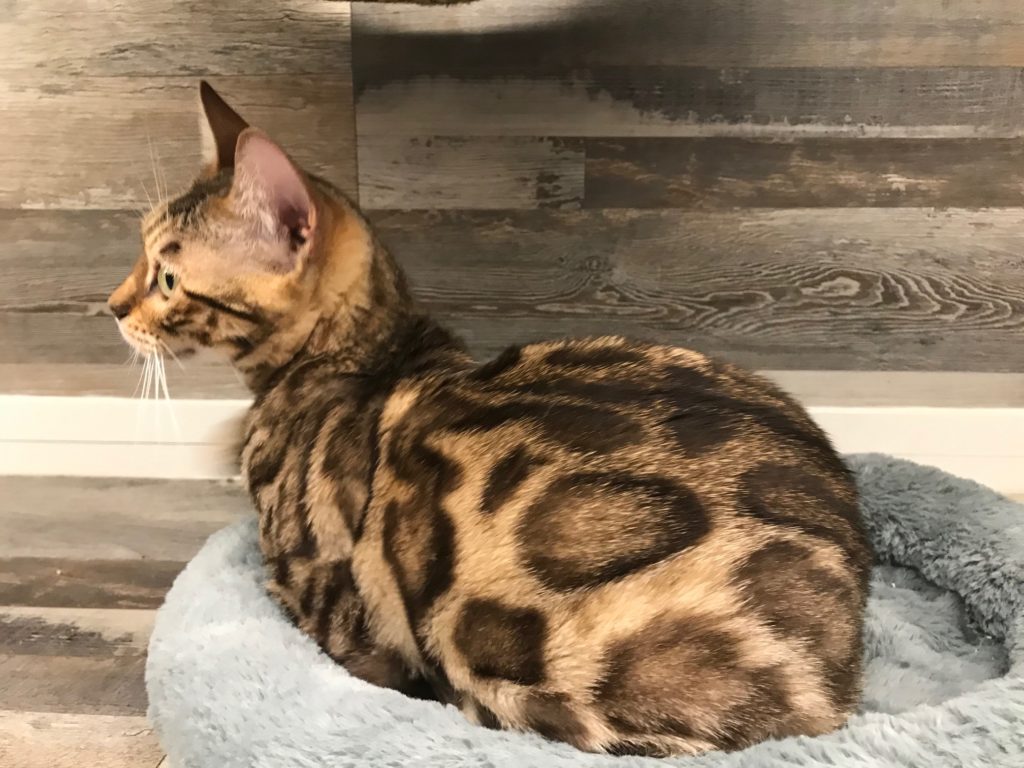
When introducing a new cat into a program, breeders are often either trying to eradicate a genetic disease or obtain a certain look.
With the case of the snow sepia Bengal, it was the latter.
The introduction of the Burmese lead to a specimen with a greater contrast in markings and base fur.

It is also considered to look most like the Snow Leopard.
This is because seal sepia snow isn’t pure white- and neither is a Snow Leopard.
Think about how a Snow Leopard’s coat will offer camouflage in a snowless, grey, brown rock-strewn environment.
Sepia’s have acquired the nickname ‘snow brown Bengals’ but neither are they truly brown- simply that little bit darker.
Instead, their base coats are cream, beige or light tan coloured with markings that are sepia brown or darker.
Sepia Bengal kittens display these marking from birth- hence this is a way of telling them apart from the snow lynx.
A sepia snow Bengal will have green or golden/orangey eyes and a light pinkish nose.

Our final snow variant is a bit of a melting pot…
Snow Seal Mink
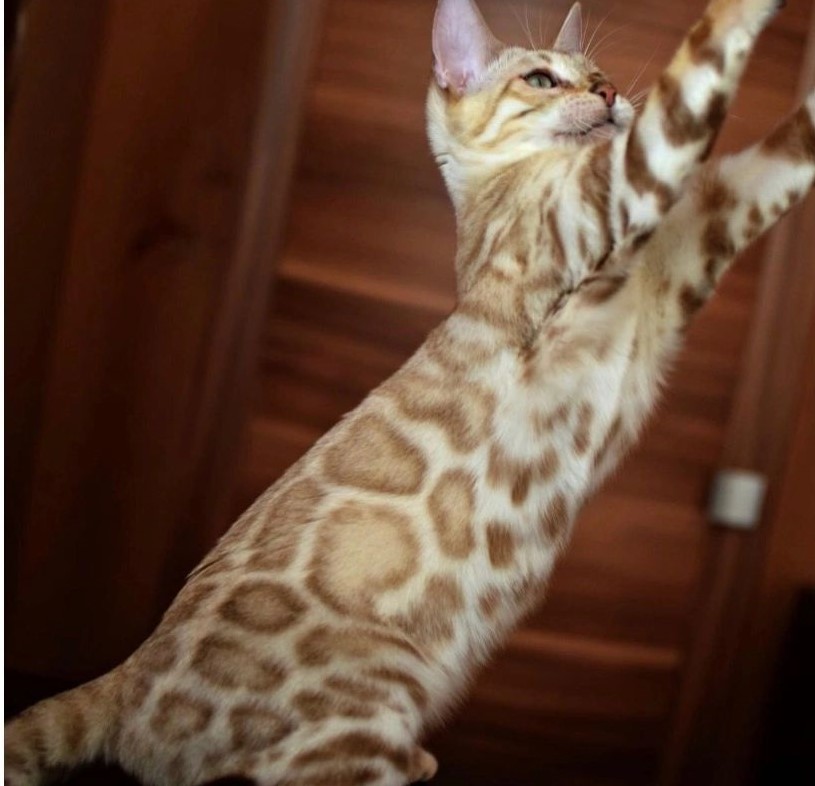
The mink snow Bengal is quite literally a mix of the lynx Bengal and the sepia in that they carry BOTH the Burmese and Siamese genes.
In terms of colouration then, this typically puts this Bengal cat somewhere between the two.
Snow minks are darker than their seal lynx kin, but not as dark as the sepias.
Look out for a white, cream very light brown coat, with light brown markings that darken with age.
Mink Bengal kittens have a fur pattern visible from birth.
A seal mink snow will usually have blue-green/aqua eyes but they can also be gold.
Expect a mink Bengal to have a dark pink or reddish nose.

Now a quick nod towards silver snows…
Silver Snow Bengal Cats
These are snow Bengals that additionally carry the silver Bengal cat inhibitor gene- which inhibits, but not totally suppresses the brown/reddish hue in brown Bengals.
When young, it’s said to be hard to visually distinguish between a snow Bengal kitten and a silver snow.
But as they age, the silver/grey background fur of the latter becomes more distinct.
These variants then, if they carry the silver Bengal inhibitor gene become:
- Silver Seal Lynx
- Silver Seal Mink
- Silver Seal Sepia
They essentially have a similar look to snows, BUT with more of a grey/silver look to them.
Charcoal snows next. You heard correctly…
Charcoal Snow Bengal Cats
Yes, they do exist which might seem a bit of a contradiction in terms.
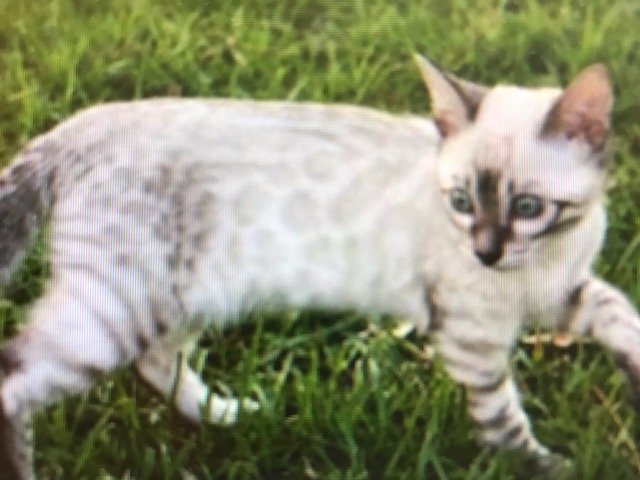
But because the charcoal trait is passed down independently of colour, a charcoal snow Bengal is possible.
And as with the silver trait, this leads to charcoal lynx, mink and sepia snows.
Unsurprisingly, charcoal snow Bengal cats have much darker, black pointed features with a darker coloured nose.
Personality Traits
Snow Bengal cats are no different to other coloured varieties when it comes to personality.
Of course, individuals within a breed may differ, but in general, you can expect a snow Bengal to be intelligent, energetic, inquisitive and sometimes (or often…) demanding. See ‘7 Things You MUST Know Before Owning A Bengal Cat.’
Are Snow Bengal Cats Rare?
They are certainly rarer than their brown counterparts having first appeared as part of the breed in the 1980s and 90s (brown Bengals originated in the 1960s).
Because of the recessive nature of the genes that give them their ‘snow’ coat features, it makes breeding a much more selective process.
So in that sense, they are that bit more difficult to create.
Is A Snow Bengal Cat Hypoallergenic?
No.
Despite what you may read elsewhere, NO CAT is scientifically proven to be hypoallergenic and Bengal cats snow or otherwise, are no different.
There is anecdotal evidence from people who say they have had less of a reaction or none at all to Bengals, but equally, there are others who still do.
The only sure-fire way of knowing whether an individual is allergic to a particular cat or breed is for that individual to spend time with that cat or breed.
For more in-depth information on this read ‘Are Bengal Cats Hypoallergenic? 5 Big Myths Explored.’
How Much Do Snow Bengal Cats Cost?
As they are rarer, snow and silver Bengals will in general command a higher price than a brown.
And snow Bengal kittens will be more expensive than an adult.
Breeders price their cats differently, and there are numerous factors which determine cost, so please see ‘Prices of Bengal Cats: The Definitive Global(ish) Guide 2021‘ for more detailed information and some numbers.
How Big Do Snow Bengal Cats Get?
A snow Bengal cat size is no different to that of a brown or any other coloured Bengal.
Figures for this vary, but roughly range from 6-10lbs (2.7-4.5kg) for a female Bengal, with males between 10-15lbs (4.5-6.8kg), though one site suggested larger specimens could weigh as much as 22lbs (10kg).
How Long Do Snow Bengal Cats Live For?
Bengal cats snow or otherwise, have a life expectancy that ranges from 12-20 with an average of around 15 years– although these figures vary slightly depending on the source.
In general, house cats liver longer as they are less likely to be involved in road traffic accidents, suffer injuries or contract disease from other cats/animals.
For more on a Bengal’s life expectancy and what you can do to extend it, see ‘How Long Do Bengal Cats Live? 12 Excellent Ways To Boost Life Expectancy.’
Do Bengal Cats Like Snow?
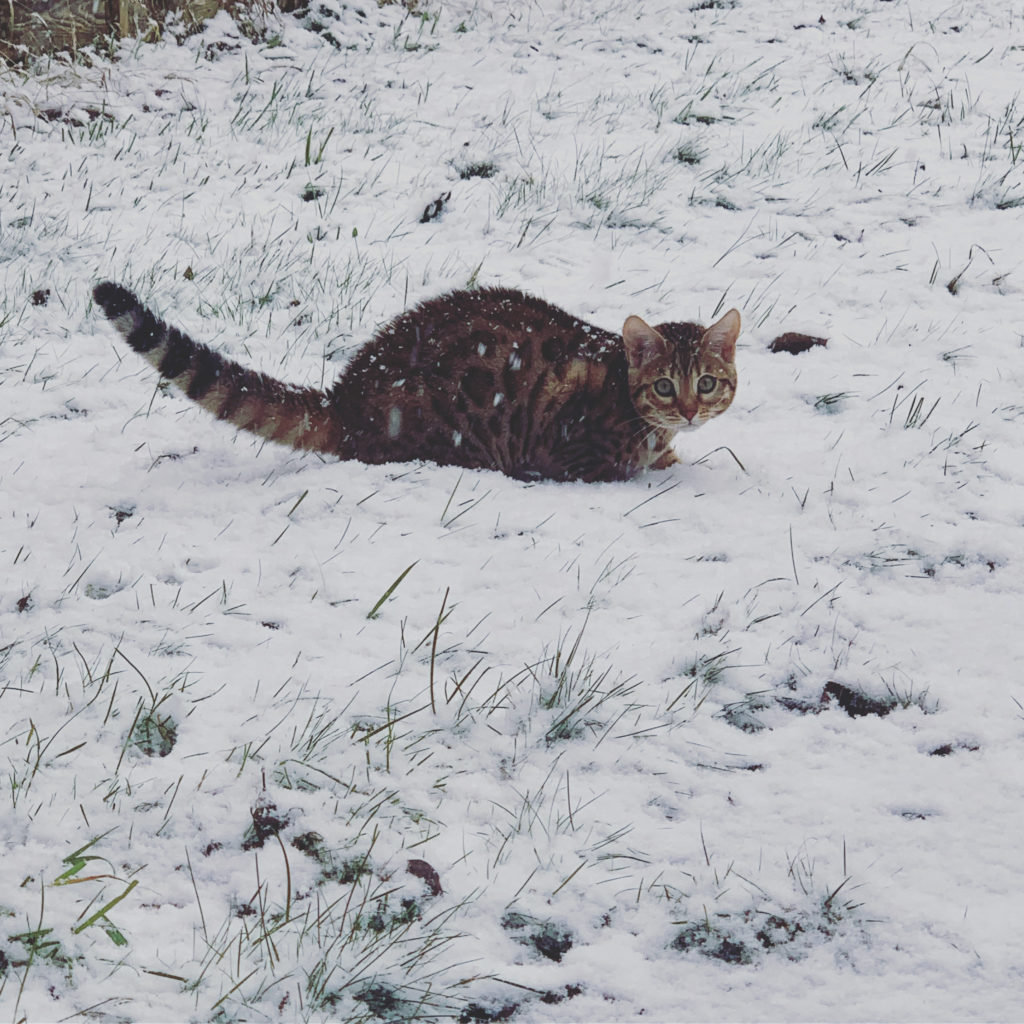
I’m not sure they’ve ever specifically been asked, but whether they like snow will vary according to each individual.
You would think that by looking like something that’s designed to live in wintery conditions a snow Bengal would be adapted to snow.
But as they’ve only been bred to look Snow Leopard-esque they are no more or less likely to enjoy the white stuff than a brown (or other domesticated cats).
Our Bengal Hazel (pictured) though, didn’t seem to have much of a problem.
Summary
Snow Bengals then are perhaps more diverse than you may have first realised owing to the genetic input of Siamese and Burmese cats.
Before acquiring any pet, it’s important to learn as much as you can as this will benefit the both of you in the long run.
This researched guide brings together all you will need to know about snow Bengals allowing you to identify the different types and their colourations, how big they can get and how long they’re likely to live.
You should even possess some basic knowledge of their genetics- something to impress any breeder with.
Indeed, knowing what to look for will help you avoid a scam.
Now that you’ve dipped your toe into the wintery world of snow Bengals, are you convinced they are right for you?
But what about Silver Bengals?
My thanks to Dawn Schwiebert from Exotic Bengals of San Diego for providing the snow Bengal photos seen in this article.

